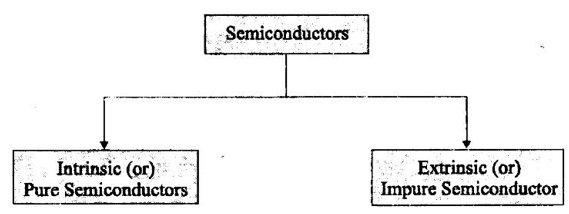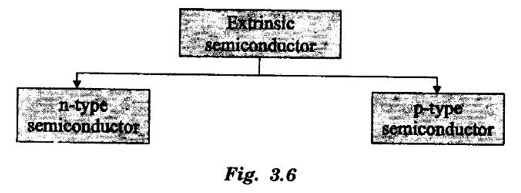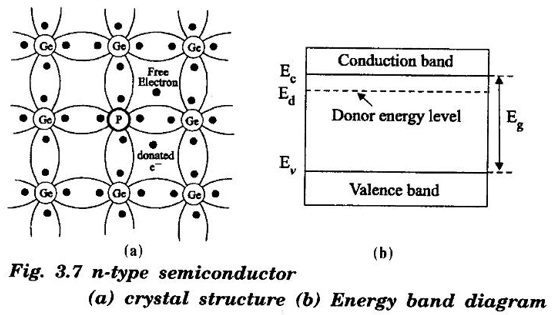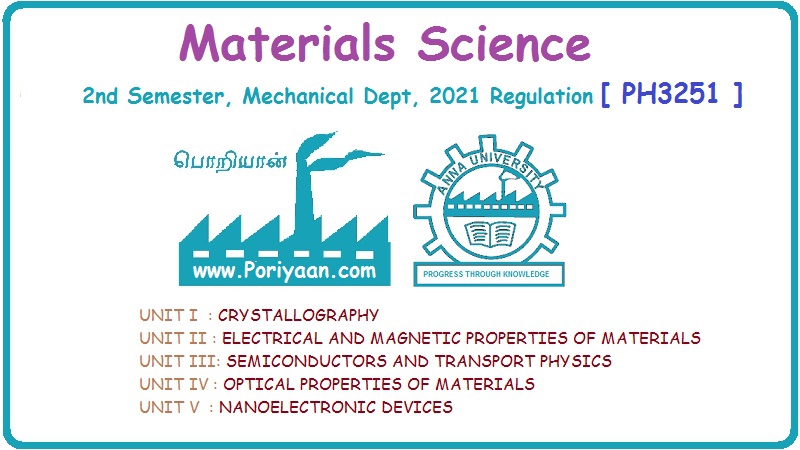Materials Science: Unit III: Semiconductors and Transport Physics
(ii) Extrinsic or Impure Semiconductors
Doping, Advantages, Types, Covalent bond, Energy band
In a semiconducting material, if the charge carriers originate from impurity atoms which are doped to the original material, then this type of semiconductor is known as extrinsic or impure semiconductor.
When a suitable impurity is added to a pure semiconductor, its electrical conductivity changes. Based on this property, the semiconductors are classified into two types. They are (i) Intrinsic semiconductor or pure semiconductor (ii) Extrinsic semiconductor or impure semiconductor or Doped semiconductor EXTRINSIC OR IMPURE SEMICONDUCTORS In a semiconducting material, if the charge carriers originate from impurity atoms which are doped to the original material, then this type of semiconductor is known as extrinsic or impure semiconductor. It is also known as doped semiconductor. Extrinsic semiconductor is obtained by adding trivalent or pentavalent impurity atoms to a tetravalent semiconductor. The electrical properties of pure semiconductors can be easily changed even with the addition of very little amount of impurities. The addition of impurities to a pure semiconductor is known as doping and added impurity is called as doping agent or dopant. The addition of impurities increases the number of free electrons and holes in semiconductor and hence increases its electrical conductivity. Some of the common doping agents are arsenic, antimony, phosphorus, gallium, aluminium and boron. These elements have either five or three valence electrons in the outermost orbit. • Electrical conductivity is high. • Electrical conductivity can be altered to any desired value by controlling of doping concentration. • Electrical conductivity is not a function of temperature. The extrinsic semiconductors are classified into two types based on the type of impurity added. (Fig 3.6) (i) n - type semiconductor (ii) p - type semiconductor n - type semiconductor When a small amount of pentavalent impurity (group V element) is doped to a pure semiconductor, it becomes n - type semiconductor. Such impurities are known as donor impurities because they donate free electrons to semiconductor crystal. Typical examples of pentavalent impurities are phosphorus, (Atomic No. 15) and antimony (Atomic No. 51). A pentavalent impurity (phosphorus) having five valence electrons is added to a pure semiconductor having four valence electrons (silicon or germanium). Now, four electrons of germanium form a covalent bond with four valence electrons of phosphorus (impurity atom). The fifth electron which is now free finds no place in covalent bond structure as shown in fig. 3.7 (a). We have one electron left free. This acts as a conduction electron. A very small amount of energy (0.01 eV for germanium and 0.05 eV for silicon) is needed to detach this fifth electron. The addition of pentavalent impurity gives a large number of free electrons (negative charges) in semiconductor. Therefore, it is called n - type semiconductor where n stands for negative type. Since every pentavalent atom contributes one free electron, in addition to thermally generated electron-hole pairs, the number of free electrons is more than the number of holes in n-type semiconductor. Thus in this case, electrons are majority charge carriers and holes are minority charge carriers. The energy band diagram of n-type semiconductor is shown in fig.3.7 (b). When the donor impurities are added, the allowable energy levels (donor energy levels) are introduced. These donor energy levels are slightly below the conduction band. They are discrete and do not form a band because the impurity atoms are far away in the crystal and hence their interaction is small. The donor energy level for germanium is 0.01 eV and for silicon it is 0.05 eV below the conduction band. Therefore, even at room temperature, almost all the fifth electrons enter into the conduction band.Types of Semiconductors

Doping
Advantages of Extrinsic semiconductors
Types of Extrinsic semiconductors

Covalent bond in n-type semiconductor
Energy band of n-type semiconductor

Materials Science: Unit III: Semiconductors and Transport Physics : Tag: : Doping, Advantages, Types, Covalent bond, Energy band - (ii) Extrinsic or Impure Semiconductors
Related Topics
Related Subjects
Materials Science
PH3251 2nd semester Mechanical Dept | 2021 Regulation | 2nd Semester Mechanical Dept 2021 Regulation
